As we celebrate the 50th anniversary of the date when the first man-made laser saw the light of day, it is important
to look back at its birth. And although that beginning took place in the hills of
sunny Malibu, Calif., on May 16, 1960, this groundbreaking invention has quite
a few European forebears and descendants.
Although it seems that, for this particular baby, a bit of disagreement
exists as to who the parents were, there is good certainty about the grandfather:
Albert Einstein. He came up with the concept of stimulated emission in 1916-17 in
his paper “Zur Quantentheorie der Strahlung” (“On the Quantum
Theory of Radiation”). Much later – but still 10 years before Maiman’s
first demonstration of a working ruby laser – another European, Frenchman
Alfred Kastler, proposed a method of optical pumping of paramagnetic atoms or nuclei
in the ground state. This was considered an important step toward lasers and earned
Kastler the 1966 Nobel Prize in physics.
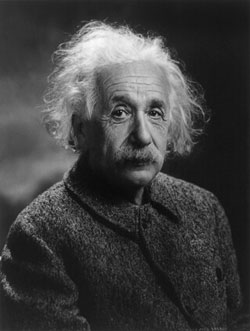
Albert Einstein is generally considered the grandfather of the
laser, thanks to his 1916-17 paper “On the
Quantum Theory of Radiation,” in which he presented the concept of
stimulated
emission.
Stanford professor Anthony Siegman, author of well-known laser
textbooks and reviews, sees the development of the laser as having been facilitated
by the postwar situation, in which many very capable scientists “returned
to their home laboratories, carrying with them … new skills and …
pieces of their wartime apparatus – waveguides, cavities, signal generators
and receivers, sensitive detection methods – which they were eager to apply
to more basic scientific pursuits. At the same time, the wartime experience …
led to unprecedented funding.” Because of the Cold War situation, financial
backing was significant in the US and the Soviet Union, leading to major, speedy
steps on both sides.
Europe was in the middle of this competition and, interestingly,
the first lasers built in Berlin were constructed around the time the Wall was built
in 1961 – “and on both sides of the Iron Curtain,” remembers Hans
Joachim Eichler, professor at the Technical University of Berlin, one of the first
places in Germany where lasers were (and still are) developed. The two researchers
who did the first experiments there, Horst Weber and Gerd Herziger, became landmark
figures on Germany’s laser scene. During their careers, they left a trail
of laser research centers that they established in Germany and Switzerland, including
the Fraunhofer Institute for Laser Technology in Aachen and Laser Medicine Technology
Berlin.
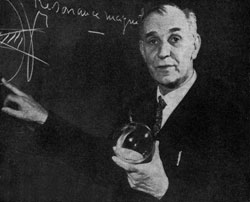
Ten years before Theodore Maiman first demonstrated a working
ruby laser, Alfred Kastler
of France proposed a method of optical pumping of paramagnetic atoms or
nuclei in
the ground state. This was an important step toward lasers and earned
Kastler the
1966 Nobel Prize in physics.
Mastering applications
“Many other of [the] top research centers for laser technology
were set up by Europeans returning from the US, such as Wolfgang Kaiser from TU
Munich, or Herbert Welling, who made Hanover a center of laser research,”
says Eichler, who made himself a name in nonlinear optics, one of the first offshoot
fields of research, which was practicably not possible without the laser. Promoting
this investigation were many European research centers, such as the Polytechnic
School of Milan, where Orazio Svelto worked on ultrashort laser pulses and solid-state
lasers, including the recent invention of the hollow-fiber compressor used in extreme
nonlinear optics and attosecond science.
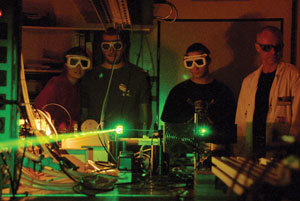
Technical University of Berlin’s laser labs host a
demonstration event during the annual Long Night
of Sciences.Courtesy of the Technical University of Berlin.
After the birth of the ruby laser, many Europeans were involved
in bringing its brothers and sisters to life. For example, groups in the UK –
such as Royal Signals and Radar Establishment under Cyril Hilsum – and in
France – Maurice Bernard and Guillaume Duraffourg, working at CNET, for example
– were strongly involved in developing the first semiconductor laser, launched
on Sept. 16, 1962, at General Electric Research Development Center in Schenectady,
N.Y. In fact, there are reports that Pierre Aigrain from École Normale Supérieure
in Paris was planning to visit the US with a working semiconductor laser in his
pocket ... in 1961.
Another sibling that was conceived almost in parallel, but independently,
in Europe and the US is the dye laser introduced in 1966 by both Fritz Peter Schäfer
at Marburg University and P.P. Sorokin at IBM. A little later, Theodor Hänsch
added frequency-selective elements to pulsed dye lasers, extending their use in
spectroscopy and atomic physics applications. Incidentally, Hänsch received
the Nobel Prize in physics for his contributions to the development of laser-based
precision spectroscopy, including the optical frequency comb technique he developed.
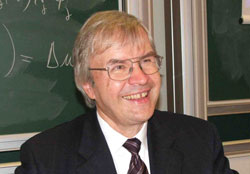
In the late 1960s, Theodor Hänsch added frequency-selective elements to pulsed dye lasers, extending their
use in spectroscopy and atomic physics applications. He was awarded the 2005 Nobel Prize in physics for his contributions to the development of laser-based precision spectroscopy.
Schäfer, however, moved to Göttigen to become director
of the Max Planck Institute for Biophysical Chemistry, from which the commercial
laser manufacturer Lambda Physik was spun off in 1971. Lambda Physik became a very
successful player in the fieof excimer and dye lasers and is now part of Coherent
Inc. Another example of an early – and yet still successful – commercial
player is French Quantel, started in 1970. Quantel remains a big player in the field
of solid-state lasers.
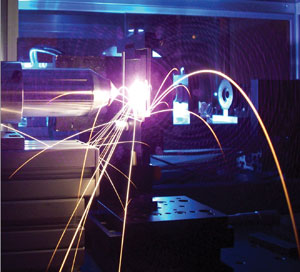
A drilling application using a solid-state laser is shown. Materials
processing was one of the first applications identified for the laser, and today
lasers have replaced classical tools in many fields. One of them is mechanical engineering,
in which European companies are historically strong and have maintained their position,
thanks to early investments in laser development. Courtesy of the Technical University
of Berlin.
In general, Europeans have been doing very well in commercializing
lasers and developing their applications. “In the early days, industrial giants
such as Siemens or Telefunken took a strong interest in developing lasers,”
Eichler said.
Take Rofin-Sinar, for example, which is a former Siemens subsidiary
and today a leading industrial laser supplier. Trumpf, an international heavyweight
in the field of metal cutting and welding, has its roots as a “classical”
machinery supplier. Berthold Leibinger saw the trend and acquired a lot of the engineering
talent in the field, recently by purchasing Southampton Photonics of the UK, a leader
in fiber lasers. The company sees great potential in fiber lasers and also in direct
applications of semiconductor lasers for materials processing.
Europe has also contributed to general laser applications in telecommunications
and consumer electronics. The extremely popular compact disc was developed by Dutch
Philips Electronics NV and subsequently commercialized in cooperation with Sony
of Japan.
Charles Kao, 2009 Nobel Prize winner, suggested glass fibers for
communications in the early 1960s while working at Standard Telecommunications Labs
in the UK. Eichler predicts further growth and progress in everyday laser use in
medicine and optical sensing. He foresees a bright future for the integration of
optics and electronics through the use of silicon photonics and polymer materials.
So there is a lot to come for the laser and its offspring, and let’s wish
them many happy returns – and many more happy children and grandchildren –
that is, technologies that would not exist without the laser.